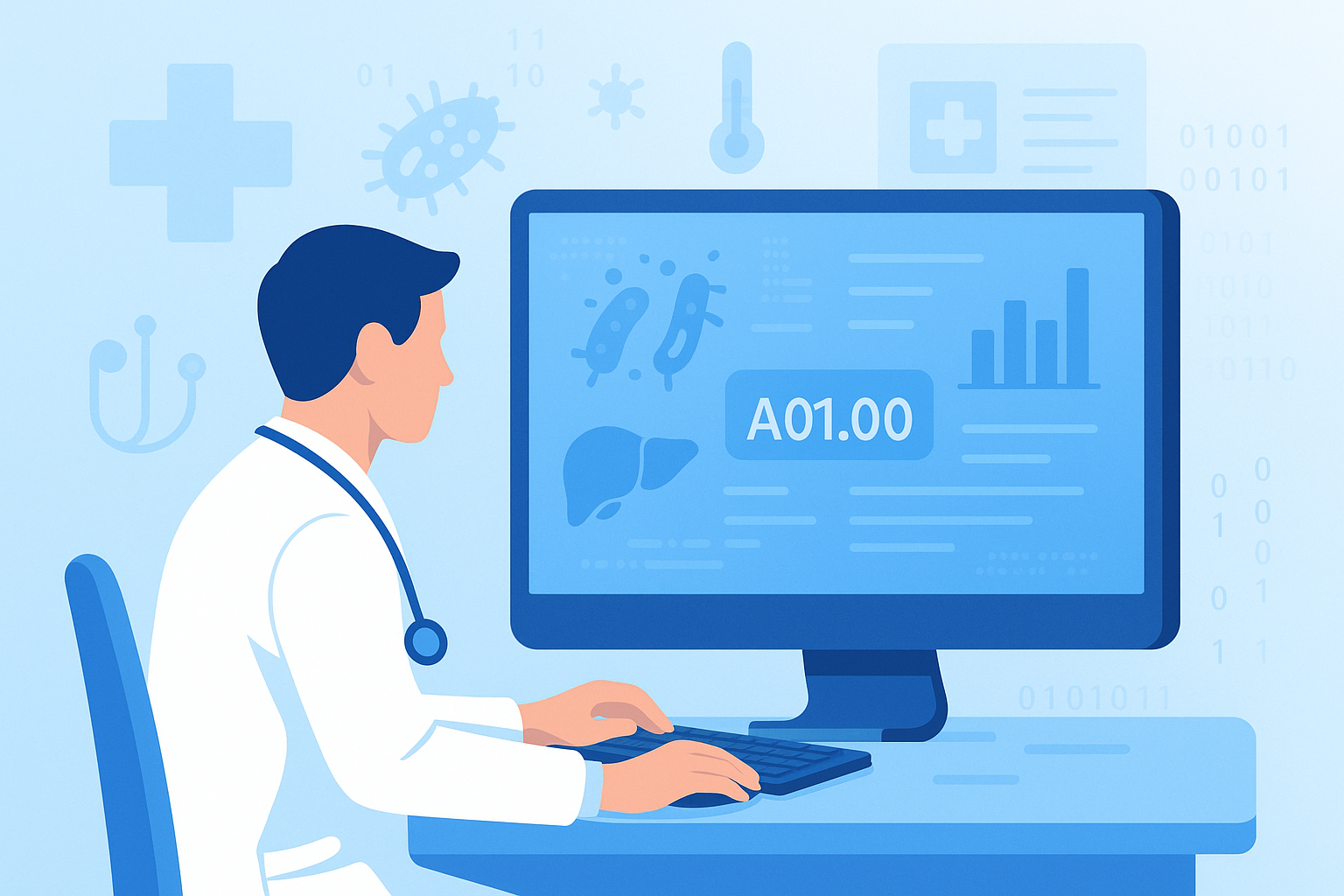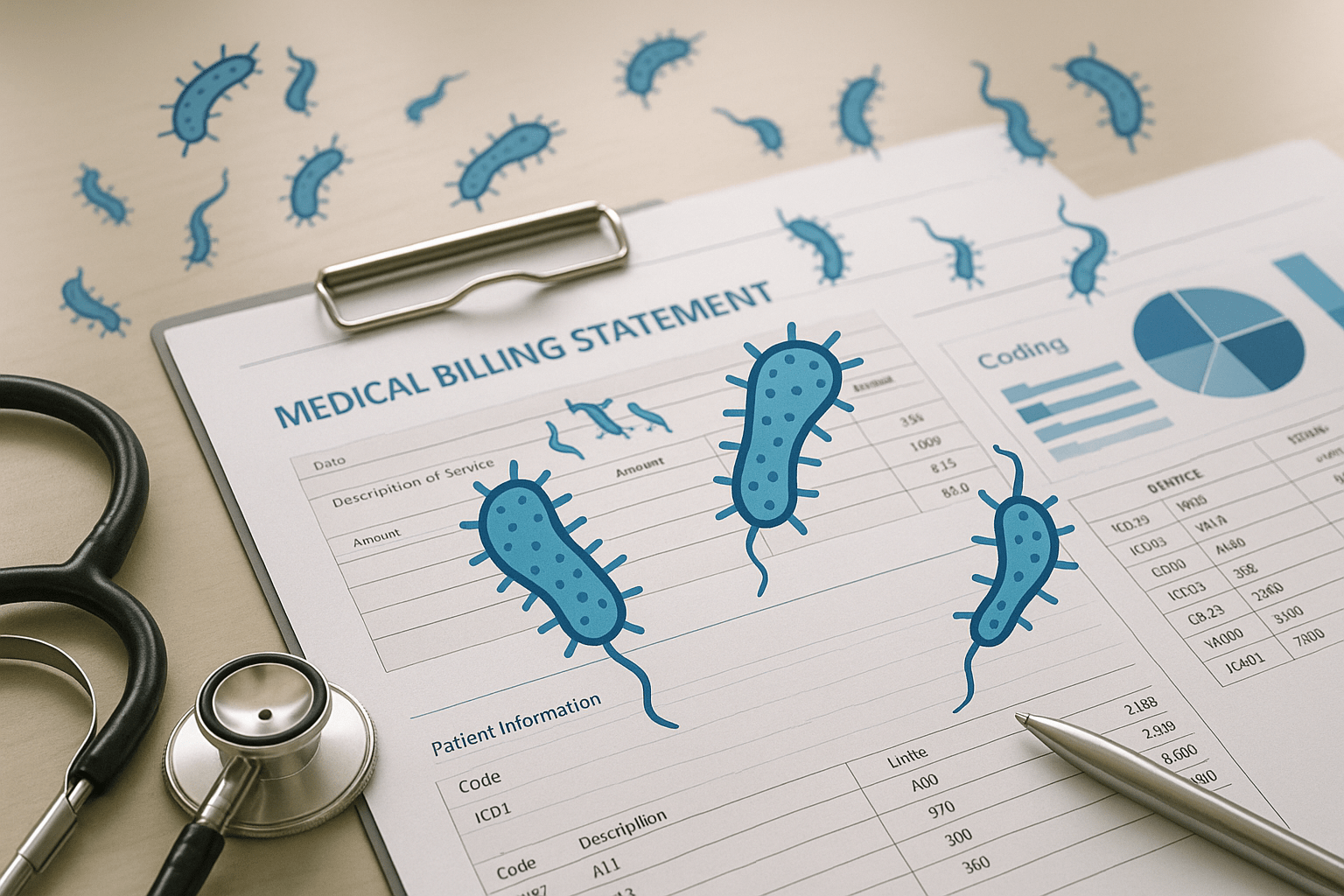Ever glanced at a medical chart and seen “typhoid fever” with a string of numbers and letters trailing behind it? Those codes aren’t just bureaucratic alphabet soup. They’re actually telling a pretty specific story about what’s happening with the patient.
Today, we’re diving into the A01.0 category of ICD-10 codes, which covers typhoid fever in all its various forms. Whether you’re a medical coder trying to nail down the right code, a biller double-checking claims, or a healthcare professional wanting to understand the coding side of things, this guide will walk you through everything in plain English.
Let’s break it down, shall we?
What is Typhoid Fever? (The Quick Version)
Before we get into the coding weeds, let’s do a super quick refresher on what we’re actually dealing with here.
Typhoid fever is a bacterial infection caused by Salmonella typhi. You typically pick it up from contaminated food or water, which is why it’s more common in areas with poor sanitation. The classic symptoms include sustained high fever, weakness, stomach pain, headache, and sometimes a rose-colored rash.
While typhoid isn’t as common in developed countries anymore (thank you, modern plumbing!), It’s still very much a concern for travelers and in many parts of the world. Globally, we’re talking millions of cases each year.
Now here’s where it gets interesting from a coding perspective: typhoid doesn’t always play nice. Sometimes it just causes fever and makes you feel awful. Other times, it decides to complicate things by affecting the heart, lungs, bones, or even the brain. And that’s exactly why we need all these different codes.
Understanding the A01.0 Code Family
Let’s zoom out for a second and look at the big picture.
In the ICD-10 system, A01 is the parent code for typhoid and paratyphoid fevers. Think of it as the main folder.
Inside that folder, A01.0 specifically covers typhoid fever (as opposed to paratyphoid, which has its own codes).
Now here’s where those extra digits come into play. Medical coding is all about specificity. The more specific you can be about what’s actually happening with the patient, the better. It helps with treatment tracking, research, insurance claims, and even public health surveillance.
The structure looks like this:
- A01.0: Typhoid fever (the general category)
- A01.00: Unspecified typhoid fever
- A01.01 through A01.09: Specific types and complications
Each of those additional digits tells us something different about how typhoid is manifesting in that particular patient. Let’s break them down one by one.
Breaking Down Each Subcode
A01.00: Typhoid Fever, Unspecified
This is your basic, straightforward typhoid fever code. The A01.00 code is used when:
- The documentation doesn’t mention any specific complications
- It’s a typical case of typhoid without any bells and whistles
- The provider simply notes “typhoid fever” without elaborating on specific organ involvement
Think of this as the default setting. Patient has typhoid, they’re sick, but there’s nothing particularly unusual or complicated going on beyond the standard symptoms.
A01.01: Typhoid Meningitis
Now we’re getting into the complicated territory. The A01.01 code is for when the typhoid bacteria decides to crash the party in the meninges (the protective membranes covering the brain and spinal cord).
This is serious business. The patient will typically have the usual typhoid symptoms plus signs of meningitis like severe headache, stiff neck, sensitivity to light, and altered mental status.
When you see documentation mentioning “meningitis secondary to typhoid” or “typhoid with meningeal involvement,” code A01.01 is your code.
A01.02: Typhoid Fever with Heart Involvement
Typhoid can affect the cardiovascular system, leading to conditions like myocarditis (inflammation of the heart muscle) or endocarditis (inflammation of the heart’s inner lining).
Look for documentation that mentions:
- Typhoid myocarditis
- Cardiac complications of typhoid
- Heart involvement in typhoid fever
- Typhoid endocarditis
This isn’t super common, but when it happens, accurate coding with A01.02 is crucial because cardiac involvement significantly changes the treatment approach and prognosis. Learn more about when to use ICD-10 code A01.02 on our detailed page.
A01.03: Typhoid Pneumonia
Sometimes typhoid bacteria finds its way to the lungs, causing pneumonia on top of everything else. Use the A01.03 code when the chart clearly indicates:
- Pneumonia as a complication of typhoid
- Pulmonary involvement in typhoid fever
- Typhoid with respiratory complications, specifically involving the lung tissue
Don’t confuse this with just having a cough or respiratory symptoms. We’re talking about actual pneumonia confirmed as a complication of the typhoid infection. For more details on coding typhoid pneumonia, check out our A01.03 code guide.
A01.04: Typhoid Arthritis
Arthritis as a complication of typhoid? Yep, it happens. The infection can cause joint inflammation, usually appearing as the patient is recovering from the acute illness.
The A01.04 code applies when you see documentation of:
- Reactive arthritis following typhoid
- Joint involvement in typhoid fever
- Typhoid with arthritis
Patients might complain of joint pain and swelling, typically in the knees, ankles, or wrists. Visit our ICD-10 code A01.04 page for coding examples and billing tips.
A01.05: Typhoid Osteomyelitis
Osteomyelitis is a bone infection, and when typhoid is the culprit, you’ll use the A01.05 code. This is one of the rarer complications, but it does occur.
The documentation might say:
- Osteomyelitis secondary to typhoid
- Bone infection due to Salmonella typhi
- Typhoid with skeletal involvement
This typically requires long-term antibiotic therapy and sometimes surgical intervention, so getting code A01.05 right is important for tracking treatment and outcomes.
A01.09: Typhoid Fever with Other Specified Complications
This is your catch-all code for when typhoid causes complications that don’t fit neatly into the categories above.
The A01.09 code is used when the patient has:
- Gastrointestinal perforation
- Hepatitis related to typhoid
- Kidney involvement
- Splenic complications
- Any other documented complication that doesn’t have its own specific code
The keyword here is “specified.” The provider needs to document what the complication is. If they just say “typhoid with complications” without saying what those complications are, you’d use A01.00 instead and query for more specifics. Read our comprehensive guide on ICD-10 code A01.09 for more examples.
Quick Context: The Rest of the A01 Family
Just so you have the full picture, here are the other members of the A01 family:
- A01.1: Paratyphoid fever A
- A01.2: Paratyphoid fever B
- A01.3: Paratyphoid fever C
- A01.4: Paratyphoid fever, unspecified
These are caused by different Salmonella strains and are clinically similar to typhoid but generally milder. They have their own codes because, from a public health and treatment standpoint, we need to know which specific bacteria we’re dealing with.
Practical Coding Tips
Documentation is Everything
The single most important thing for accurate coding? Good documentation from the provider. You can’t code what isn’t documented, no matter how much you might suspect what’s going on.
If you’re seeing vague documentation like “typhoid with complications” without any specifics, that’s your cue to query the provider. Ask them to clarify what complications they’re seeing.
The Unspecified vs. Specified Decision
Here’s a simple way to think about it:
Use A01.00 when:
- No complications are mentioned
- Documentation is vague or incomplete
- It’s straightforward typhoid fever
Use a specific code (A01.01-A01.09) when:
- The provider clearly documents a particular complication
- There’s evidence of organ-specific involvement
- The medical record supports the specific diagnosis
When in doubt, go with unspecified and query for clarification. It’s better to use a less specific code accurately than to use a more specific code incorrectly.
Common Mistakes to Avoid
Mistake #1: Automatically using A01.00 for every typhoid case without checking for documented complications.
Mistake #2: Using multiple A01.0 codes for the same episode. Pick the one that best represents the primary or most significant presentation.
Mistake #3: Coding complications that aren’t specifically documented. Your clinical knowledge might tell you something’s probably happening, but if it’s not in the chart, you can’t code it.
Mistake #4: Confusing typhoid (A01.0) with paratyphoid (A01.1-A01.4). Check which organism was identified.
What to Look for in the Medical Record
To code accurately, scan the documentation for:
- Lab results confirming Salmonella typhi
- Any mention of organ systems affected
- Complications listed in the assessment or problem list
- Treatment notes that might indicate specific complications (like if they’re treating meningitis or pneumonia)
- Consultation notes from specialists (cardiology, neurology, etc.)
Your Quick Reference Guide
Here’s a clean list you can bookmark for quick lookups:
- A01.00: Typhoid fever, unspecified
- A01.01: Typhoid meningitis
- A01.02: Typhoid fever with heart involvement
- A01.03: Typhoid pneumonia
- A01.04: Typhoid arthritis
- A01.05: Typhoid osteomyelitis
- A01.09: Typhoid fever with other specified complications
Wrapping Up
The A01.0 code family might seem like splitting hairs at first glance, but each of those subcodes serves a real purpose. They help us track how typhoid presents, which complications are most common, how treatment is progressing, and where public health resources need to focus.
For coders and billers, nailing these codes means cleaner claims and fewer denials. For healthcare providers, it means better data on patient outcomes. And for the bigger healthcare system, it means more accurate disease surveillance and research.
The next time you’re coding a typhoid case, take that extra moment to check the documentation thoroughly. Is it straightforward typhoid (A01.00), or is there something more specific going on? That little bit of extra attention makes a real difference.
Need to look up other ICD-10 codes? Browse our complete database for detailed breakdowns of every code category. And if you found this helpful, check out our other guides on infectious disease coding.





